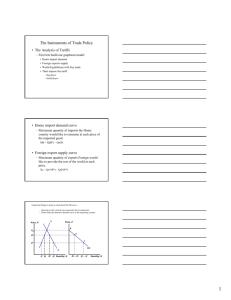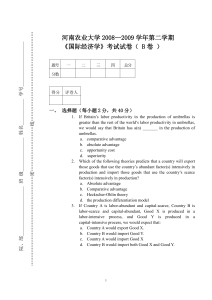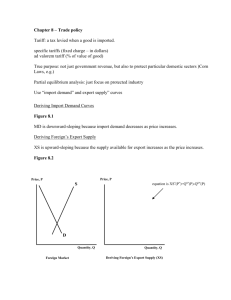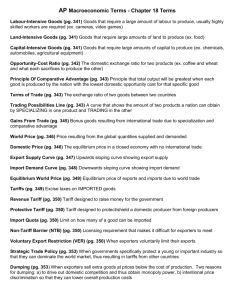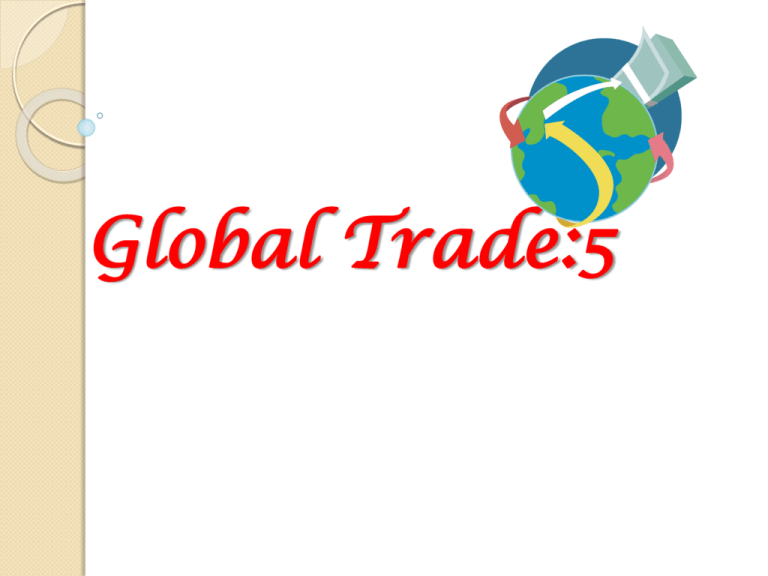
Global Trade:5
Global Trade: Lessons
Lessons
Topics
Lesson 1
The World Economy and Global Trade:
An Overview and Stylized Facts on Global Trade
Lesson 2
Lesson 3
Lesson 4
Lesson 5
Lesson 6
Theories of International Trade-I:
The Ricardian Model:
Labor Productivity and Comparative Advantage:
Theories of International Trade-II:
The Heckscher-Ohlin Model:
Factor Endowments and Comparative Advantage
Theories of International Trade-III:
The Standard Trade Model and Gains from Trade
Combination of Labor Productivity and Factor Endowments
Policy Instruments of International Trade:
Tariffs, Export Subsidies, Import Quotas, Export Restraints
Policy Issues of International Trade:
1) Free Trade vs. Protectionism
2) Liberalization in Developing Countries
3) The Role of the World Trade Organization
2
Texts
Main Text: Required:
1. International Economics: Theory & Policy, Krugman, P.R., and Obstfeld, M.,
8th Edition, Pearson-Addison-Wesley.
Recommended:
1.
International Economics, Husted, S., and Melvin, M., 8th Edition, AddisonWesley.
2.
International Economics, Gerber, J., 5th Edition, Addison-Wesley.
3.
World Trade and Payments: An Introduction, Caves, R.E., Frankel, J.A., and
Jones, R.W., 10th Edition, Pearson-Addison-Wesley.
4.
The World Economy: International Trade, Yarbrough, B.V., and Yarbrough,
R.M., 7th Edition, Thomson-South-Western.
5.
Principles of Microeconomics, Only Chapter 3: Interdependence and the
Gains from Trade, Mankiw, N.G., 5th Ed., South-Western Cengage Learning.
3
Lesson 5
Lesson 5: Trade Policy Instruments
Procedure: The PowerPoint Presentation
Duration: 60 minutes
Overview
This lesson discusses different policy
instruments of international trade: tariffs,
export subsidies, import quotas, and
voluntary export restraint.
4
Lesson 5 (cont.)
Outline
List of Class needs: the text, a computer, and a
notebook.
Pre-class reading and preparation: Chapter 8 of the
text.
Activities and timing: Go over the entire presentation
in 60 minutes and think about the main findings of the
lesson. Practice all diagrams in this section.
Identification of Learning Objectives: Objective #5
from Section I
Identification of the Global Workforce Skills for the
lesson: Skill points 3 and 4 from Section II
5
Lesson 5 (cont.)
Lesson notes and suggestions for Instructors: Read
the relevant chapters in the recommended texts
and look for online data for the latest figures of
global trade.
Acknowledgment: The Course Developer took help of
different sources as referred while preparing the study
materials. When a considerable number of diagrams have
been developed to enhance interest in the subject, many
diagrams come from the required text for the convenience
of the students.
6
The instruments of trade policy
Previous Lessons have answered the question,
“Why do nations trade?”
While this question is interesting in itself, its
answer is much more interesting if it helps
answer the question, “What should a nation’s
trade policy be?”
This lesson examines the policies that
governments adopt toward international trade,
policies that involve a number of different
actions.
7
The instruments of trade policy (cont.)
The main instruments covered in this
Lesson are:
1)
Tariffs
2)
Export subsidies
3)
Import quotas
4)
Voluntary export restraint
8
Tariff
A tariff, the simplest of trade policies, is a
tax levied when a good is imported.
A specific tariff is levied as a fixed charge
for each unit of imported goods. For
example, $1 per kg of cheese
An ad valorem tariff is levied as a fraction
of the value of imported goods. For
example, 25% tariff on the value of
imported cars.
9
Supply, Demand, &Trade
Suppose that in the absence of trade the
price of wheat in the foreign country is
lower than that in the domestic country.
With trade the foreign country will
export: construct an export supply curve
With trade the domestic country will
import: construct an import demand
curve
10
Export supply & import demand
An export supply curve is the difference
between the quantity that foreign
producers supply minus the quantity that
foreign consumers demand, at each price.
An import demand curve is the difference
between the quantity that domestic
consumers demand minus the quantity
that domestic producers supply, at each
price.
11
Deriving Home’s Import Demand Curve
As the price of the good increases, Home consumers
demand less, while Home producers supply more, so that
the demand for imports declines.
12
Deriving Foreign’s Export Supply Curve
As the price of the good rises, Foreign producers supply
more while Foreign consumers demand less, so that the
supply available for exports rises.
13
Supply, Demand, &Trade
In equilibrium, the quantities of
import demand = export supply
Domestic demand – domestic supply =
foreign supply – foreign demand
In equilibrium, the quantities of
world demand = world supply
14
World equilibrium
The
equilibrium
world price is
where Home
import
demand (MD
curve) equals
Foreign
export supply
(XS curve).
15
Effects of a tariff
A tariff can be viewed as an added cost of
transportation, making sellers unwilling to ship
goods unless the price difference between the
domestic and foreign markets exceeds the tariff.
If sellers are unwilling to ship wheat, there is
excess demand for wheat in the domestic
market and excess supply in the foreign market.
The price of wheat will tend to rise in the
domestic market. The price of wheat will tend
to fall in the foreign market.
16
Effects of a tariff (cont.)
Thus, a tariff will make the price of a good rise
in the domestic market and will make it fall in
the foreign market, until the price difference
equals the tariff.
PT – P*T = t
PT = P*T + t
The price of the good in foreign (world) markets
should fall if there is a significant drop in the
quantity demanded of the good caused by the
domestic tariff.
17
Effects of a tariff (cont.)
A tariff raises the price in Home while lowering the price
in Foreign. The volume traded declines (Note: The
description of the diagram follows in next pages).
18
Effects of a tariff (cont.)
The previous figure illustrates the effects of a
specific tariff of $t per unit of wheat (shown as t
in the figure). In the absence of a tariff, the price
of wheat would be equalized at PW.
With the tariff in place, shippers are no willing to
move wheat from Foreign to Home unless the
Home price exceeds the Foreign price by at least
$t. Thus the price in Home will rise and that in
Foreign will fall until the price difference is $t.
19
Effects of a tariff (cont.)
The tariff raises the price in Home to P and
lowers the price in Foreign to PT* = PT – t. In
Home producers supply more at the higher price,
while consumers demand less, so that fewer
imports are demanded. In Foreign the lower
price leads to reduced supply and increased
demand, and thus a smaller export supply.
Thus the whole volume of wheat traded declines
from Q W, the free trade volume, to QT, the
volume with a tariff.
20
Costs & benefits of tariffs
A tariff raises the price of a good in the
importing country, so we expect it to hurt
consumers and benefit producers there.
In addition, the government gains tariff
revenue from a tariff.
21
Export subsidy
An export subsidy can also be specific or ad
valorem
A specific subsidy is a payment per unit
exported. An ad valorem subsidy is a payment
as a proportion of the value exported.
22
Export subsidy (cont.)
An export subsidy raises the price of a
good in the exporting country, while
lowering it in foreign countries.
Also, government revenue will decrease.
In contrast to a tariff, an export subsidy
worsens the terms of trade by lowering
the price of domestic products in world
markets.
23
Effects of an export subsidy
An export
subsidy raises
prices in the
exporting
country while
lowering them
in the importing
country.
24
Effects of an export subsidy (cont.)
An export subsidy unambiguously produces a negative
effect on national welfare.
The triangles b and d represent the efficiency loss.
◦ The subsidy distorts production and consumption
decisions: producers produce too much and
consumers consume too little compared to the
market outcome.
The area b + c + d + f + g represents the cost of
government subsidy.
◦ In addition, the terms of trade decreases, because
the price of exports falls in foreign markets to P*s.
25
Import quota
An import quota is a restriction on the
quantity of a good that may be imported.
This restriction is usually enforced by issuing
licenses to domestic firms that import, or in
some cases to foreign governments of
exporting countries.
A binding import quota will push up the price
of the import because the quantity
demanded will exceed the quantity supplied
by domestic producers and from imports.
26
Import quota (cont.)
When a quota instead of a tariff is used to
restrict imports, the government receives
no revenue.
Instead, the revenue from selling imports at
high prices goes to quota license holders:
either domestic firms or foreign
governments.
These extra revenues are called quota rents.
27
Effects of the U.S. Import Quota on Sugar
28
Effects of the U.S. Import Quota on Sugar
(cont.)
As the previous figure shows, the sugar import
quota holds imports to about half the level that
would occur under free trade.
The result is that the price of sugar is $418 per
ton, versus the $210 price on world markets. This
produces a gain for U.S. sugar producers, but a
much larger loss for U.S. consumers.
There is no offsetting gain in revenue because the
quota rents are collected by foreign governments.
29
Voluntary export restraint
A voluntary export restraint works like an import
quota, except that the quota is imposed by the
exporting country rather than the importing
country.
However, these restraints are usually requested
by the importing country.
The profits or rents from this policy are earned by
foreign governments or foreign producers.
Foreigners sell a restricted quantity at an
increased price.
30
Activity/Homework
Make a summary of the effects of the
different instruments on trade policy.
If you are asked to adopt a single trade
policy, which one would you support and
why?
31




